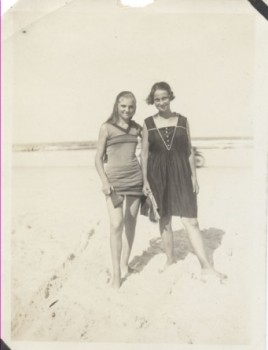Measuring Morals?

By Karen Lamoree, Archives and Collections Manager
One of these young ladies was a lawbreaker! Under the 1920 Pablo Beach Purity Ordinances, the young lady on the left could have been arrested for indecency. Those ordinances were hardly the first attempt, however, to regulate women’s beachside attire.
In 1907, the newly formed Pablo Beach town council voted to limit wearing bathing suits to the beach only and to prohibit “indecent” bathing suits. The ban was no doubt due to the introduction in Boston that year of one piece wool suits by Australian swimmer Annette Kellerman, for which she was arrested. Bathing suits were changing to swimming suits, as activities more athletic than standing and splashing in water for women were increasing in popularity. The heavy skirted suits were impractical and dangerous for actual swimming.
Nonetheless, beachside communities in the United States, England, and France kept trying to hold back the tide on “indecent” women’s bathing suits by enacting laws for nearly the next twenty years. Local historian Nelle Wales Pritchard would recall a 1917 effort in Pablo Beach, where local laws were passed governing “the outfits of women bathers. No bare legged women – no sir! Each MUST wear stockings, and might be rented, or purchased at the local Ten Cent Store for a dime. We could hold forth on those bathing suits for women, for pages – made mostly of bombazine…trimmed with ruffles which bore rows and rows of soutache braid on their edges. ..And yet, in spite of those old suits we fell in love and got married.”
Just three years later, Pritchard’s sister, Clare Wales Belt, would lead a local group of women to form a Mothers’ Club to “Improve the morals of the beach and the conduct of the visitors, who are prone to think they can do anything at the beach and get away with it. “ Their ire was directed at women’s bathing suits and scandalous Jazz Age dances, such as the Shimmy, seen at Mrs. Phinney’s Dance Pavilion. With no fuss, the Mothers’ Club convinced the town council to enact Purity Ordinances. The Shimmy and “cheek” dances were banned. Both women and men’s bathing suits were to have skirts – although the male lifeguards were exempt. Women’s skirts had to fall to within two inches of the knee.
How would these Purity Ordinances be enforced? Again, like many beach communities in the country, Pablo Beach would hire its first policewoman to do the measuring of skirts and morals. Local real estate agent and telephone operator Anna Hawkes was hired to police the beach with a measuring tape.
Were women cited for indecent bathing suits on the beach? Did couples stop doing the Shimmy? To learn the answers to these questions, make sure to visit our upcoming women’s history exhibit!



